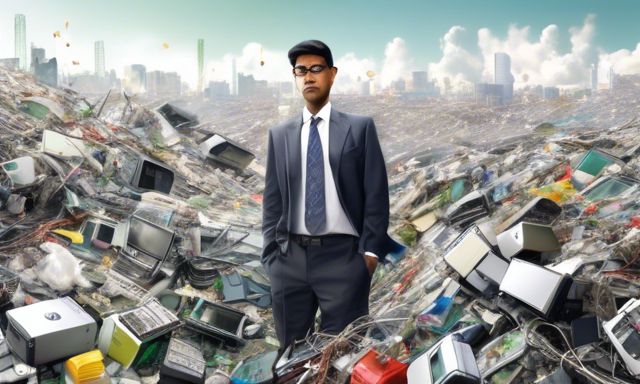The Rise of E-Waste from the AI Boom: A Hidden Dilemma for Crypto Investors
Imagine this: you’re out enjoying a sunny afternoon, sipping on some cold brew that’s helping you chill out after a long week. Suddenly, your buddy starts going off about the latest AI tool that just dropped, claiming it’ll change everything in the tech landscape. I mean, he’s probably right; AI is blowing up, and it’s hard to argue against its impact. But while you’re daydreaming about crypto gains and diving headfirst into the next big project, it hits you—what about the unseen consequences of all this tech innovation?
This is where the conversation gets a bit messy, yet super insightful for all of us—especially those looking at investments in both AI and crypto. So sit tight, because we’re diving into the tidal wave of electronic waste (e-waste) that’s emerging from the AI boom and how it intersects with our crypto world.
Key Takeaways
- AI’s Environmental Impact: AI technologies are driving unprecedented growth in e-waste, with large language models (LLMs) alone set to produce millions of tons annually.
- Investor Opportunities: The metals found in e-waste represent a significant potential return, with proper recycling processes estimated to inject billions back into the economy.
- Mitigating E-Waste: Strategies exist to prolong the lifespan of AI servers and reduce electronic waste by enhancing maintenance and thoughtful repurposing of tech.
Unpacking the E-Waste Phenomenon
The numbers can get a bit staggering. According to a recent study, AI is projected to generate around 2.75 million tons of e-waste annually thanks to the rapid adoption rates of powerful computing and data processing hardware. Just so you’re aware, by 2030, that number could soar to 16 million tons if AI continues its current growth trajectory. That rate of growth? It’s about 110% a year, which is, no exaggeration, massive compared to conventional e-waste growth of around 2.8%.
Now, here’s the kicker—North America alone is responsible for 58% of this newly minted e-waste. That’s a heavy burden to bear, considering the toxic elements like lead, cadmium, and mercury that may seep into our soil and water as this e-waste piles up. Fellow investors, this could impact not just national policies but local community health.
The Financial Angle: Shine or Rust?
Alright, let’s break it down with some positive vibes here. If done right, this situation could present unique investment opportunities, especially for the environmentally-conscious investor. Recovering precious metals from e-waste could potentially yield around $70 billion for the economy. This isn’t chump change. Gold, silver, and platinum are not just shiny objects; they could be the next gold rush, but with the added weight of responsibility as we navigate this environmental challenge.
Cooling Off: Practical Tips for Responsible Investing
Now, if you’re thinking about jumping into AI or crypto investments, don’t just ride the hype train without doing your due diligence. Here are a few tips to keep in mind as you explore:
- Research Companies’ Sustainability Practices: Look at how companies manage their e-waste. Are they investing in recycling efforts?
- Support Circular Economy Initiatives: Companies that are focusing on sustainable practices often gain consumer loyalty, and that can translate to higher stock prices.
- Diversify Your Portfolio: Consider cryptocurrencies and companies involved in clean technology or those efficient in chip production. Perform numbers on their environmental impact before investing.
- Engage with Communities: Join discussions in the crypto and AI fields about best practices; you might find beneficial insights for smarter, greener investments.
My Two Cents: The Future is Green
Honestly, as a young crypto analyst, the financial potential here feels huge, but it’s also kinda nerve-wracking. Think about it—if we don’t have a planet to live on, what good are all these investments?
Driving this point home, experts say we can cut down three-quarters of this e-waste (how wild is that?) just by maintaining servers better and repurposing hardware for lesser tasks. Before tossing out these machines, let’s find other lives for them—like educational projects or community tech initiatives. It’s about maximizing resources and minimizing waste.
A Question Worth Pondering
So, as we hit the fast lane of AI advancements, let’s not forget to check our rearview mirrors every now and then. Are we as focused on sustainability as we are on ROI? As you sip that cold brew, think about this: How can we, as investors and enthusiasts, harness technology while being responsible stewards of the environment?





 By
By


 By
By

 By
By